Mission Statement
We are committed to providing excellent public service and safety to all who live, work and play in our vibrant, tropical, historic community.
On May 8, 2019, the Mayor and City Commission adopted Ordinance No. 2019-4263, which implemented new rules and regulations for kiteboarders, including requiring all kiteboarders to obtain a Kiteboard Operator Permit by October 1, 2019. The section of the City Code governing kiteboard operators can be found here.
Subject to the requirements specified in the ordinance, Kiteboard Operator Permits are available for a fee of $46 and are valid for a period of five (5) years from the date of issuance.
Kiteboard Operator Permits may be applied for online or in person. The application is available online here and in person at the City of Miami Beach Customer Service Center, located at 1755 Meridian Avenue, Suite 100.
In conjunction with the permit, the City will issue a laminated kiteboard identification card and an identification streamer. If applying in person, subject to application approval, you will receive your permit, ID card and streamer at the time of application. If applying online, you may choose either to have the permit, ID card and streamer mailed to you or picked up in person at the Customer Service Center.
Except for 25 Street, kite surfers are not allowed south of 29 Street, and are prohibited from launching in restricted swim areas within 400 feet of all Miami Beach lifeguard stands. They must also maintain a 300 foot distance from the shoreline.
Please report any kite surfer operating outside of these parameters by calling 305.604.CITY (2489)
The following information is posted on all lifeguard towers:
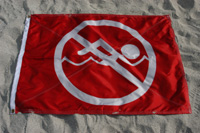 |
Red with a line crossing out a swimmer: Water Closed to Public , Agua Cerrada al Publico |
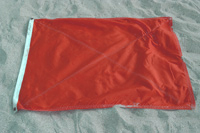 |
Red: High Hazard - High Surf and/or Strong Currents , Peligro Alto, Resaca Alta y/o Corrientes Fuertes |
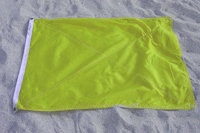 |
Yellow: Medium Hazard - Moderate Surf and/or Currents , Peligro Medio Resaca Moderada y/o Corrientes Fuertes |
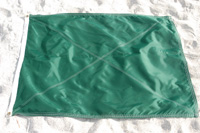 |
Green: Low Hazard - Calm Conditions, Exercise Caution , Peligro Bajo, Condiciones Calmas, Tenga Cuidado |
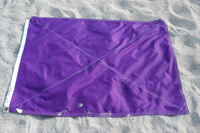 |
Purple: Dangerous Marine Life , Vida Marina Peligrosa |
Note: We will continue to use our pictured banners to enhance the Statewide flags. The flags will be flown when lifeguards are on duty. Absence of Flags Does Not Assure Safe Waters
Approx. 7,000 boating accidents happen every year, involving about 8,000 boats, resulting in nearly 800 fatalities and about $25 million in property damage.
Learn About:
Q. What is a "Rip Current?"
A rip current is a seaward stream. It is caused by an excessive amount of water that has come inside a sand bar over which waves have broken toward the shore. This accumulation of water becomes higher than sea level and flows seaward through deeper areas of the sandbar where waves are not breaking ashore.
Rip currents are visible from shore. There are several "signs" that they exist. Look for the following indicators to determine their location:Sandy-colored areas. This indicates that a rip current is forming by 'washing-out' sand from the bottom as the water flows seaward. Dark-colored water. This defines the deeper areas. Slots of darker water indicate where rip currents have already formed. A line of seaweed, foam, and/or debris extending seaward. You are witnessing items brought over the sandbar with the waves washing back out to sea with the rip current. An area of confusing waves. This choppy area resembles the surface water inside a washing machine. Rip currents are not always easily discernible to the untrained eye. An experienced ocean lifeguard with an elevated vantage point, will know where the rip currents exist. This helps them direct bathers away from these dangerous areas. Always swim in a guarded area.
Q. When is it conducive for rip currents to exist on beaches?
Anytime waves are "breaking" toward shore, that volume of water must flow back out to sea by gravity. A "breaking wave" is a wave in which water (white in appearance) is physically moving toward shore. It is caused by water spilling or plunging down the wave faces. A "swell" on the other hand, is only a wave energy form; that is, water moving on a vertical plane (up & down) rather than forward. A swell may become a breaking wave when it reaches sufficiently shallow waters.
Most waves are formed from the force of wind against the water. Sometimes waves travel thousands of miles across open seas from storms. Usually, however, local winds cause waves at our shores. Therefore, one may expect rip currents on days with strong onshore winds.
Q. How would some one caught in a rip current free himself?
Rip currents may become strong enough to pull the best of swimmers out to sea. The best method of escape would be to swim sideways from the pull of the current, then swim to shore and allow the waves to push you towards the shore. It is important to move a considerable distance from the rip current so as not to be fed back into it from the lateral (parallel to shore) current.
Even with this knowledge, it may not be as simple as it sounds. For your own safety, it's best to swim near a lifeguard stand.
National Weather Service - Rip Current Safety
United States Lifesaving Association
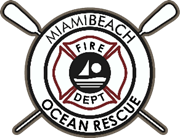
Ocean Hotline
For comments, questions, daily beach conditions, or more information, please contact the Ocean Rescue Hotline at (305) 673-7714 (option #1 for weather conditions)


 83°
83°